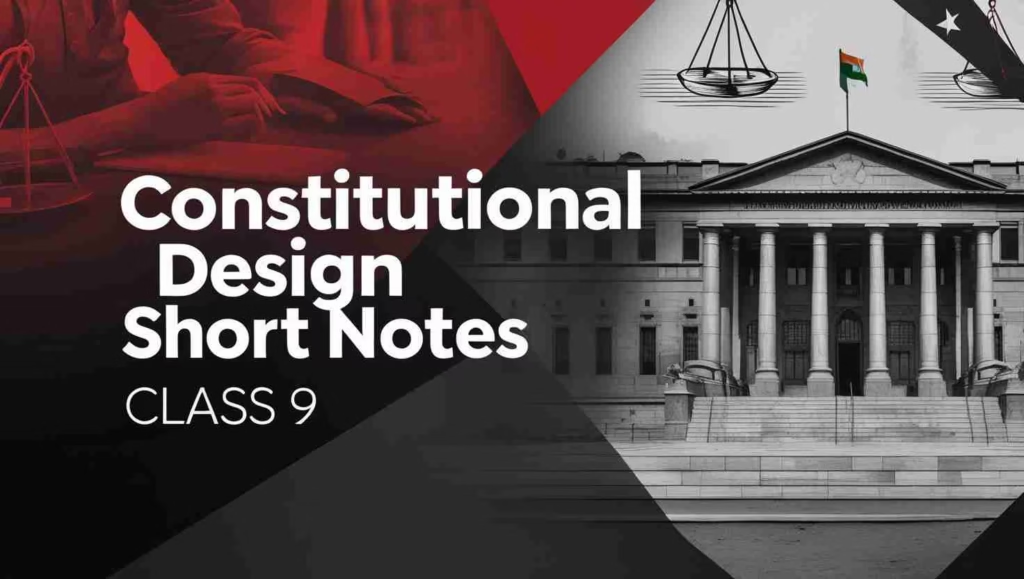“Socialism in Europe and the Russian Revolution: What If You Had to Choose Between Starvation… or Revolt?”
It’s 1917. You’re shivering in a threadbare coat, your stomach growling louder than the clanking factory machines. A loaf of bread costs a month’s wages. Down the icy streets of Petrograd, a defiant crowd marches, shouting, “Peace! Land! Bread!” — and you have seconds to decide: Do you join them, risking bullets for a sliver of hope? Or do you turn back, doomed to silent hunger?

This isn’t fiction. It’s Socialism in Europe and the Russian Revolution — a firestorm of desperation, daring, and radical dreams that reshaped the modern world.
💡 Here’s the twist that changed history:
- The Tsar’s palace glittered with gold chandeliers, while workers’ children starved, resorting to eating glue.
- A single protest by women — exhausted from watching their babies cry for food — ignited the revolt that shattered a 300-year-old dynasty.
- Lenin’s promise of socialism in Europe through revolution became reality… until Stalin twisted utopia into a nightmare.
Why care today? Because Socialism in Europe and the Russian Revolution isn’t just a chapter in your textbook — it’s a mirror reflecting how inequality, courage, and ideology collide. It’s proof that ordinary people can topple empires… and a warning of how power can corrupt even the noblest ideals.
Ready to decode the secrets, scandals, and sacrifices behind the world’s first socialist state? Dive into the chaos, triumph, and tragedy of Socialism in Europe and the Russian Revolution — where frozen streets, bloody banners, and unyielding hope forged a new era.
Table of Contents
🌍 Why Did the French Revolution Shock the World?
The French revolution may be called the dnace rehersal for the socialism in europe and the russian revolution.
Imagine playing a game where only a few players make all the rules. That’s how Europe worked before the 1700s! Kings, churches, and nobles (aristocrats) controlled everything. But the French Revolution (1789) changed the game!
What Happened?
- Before: Society was split into strict groups called estates (like levels in a video game). The top levels had all the power.
- After: People screamed, “Why should only a few control everything?” Ideas of freedom and equality spread like wildfire!
Fun Fact:
Raja Rammohan Roy in India got so inspired by the French Revolution that he fought against unfair practices like Sati! 🔥
Real-Life Connection:
Ever seen hashtags like #JusticeForAll trending online? The French Revolution was like the original viral movement—it made people globally question unfair systems!
🤔 Conservatives vs. Liberals vs. Radicals: Who Wanted What?
After the Revolution, people argued about how much change was needed. Think of it like your family debating what movie to watch:
| Group | What They Wanted |
|---|---|
| Conservatives | “Let’s stick to old movies!” |
| Liberals | “Try new types but keep favorites” |
| Radicals | “Throw out the old playlist!” |
Real-Life Connection:
Debates over school uniforms are similar! Some say “Keep the old rules!” (conservatives), others say “Let us wear casual clothes!” (liberals), and a few demand “No dress code at all!” (radicals). 😅
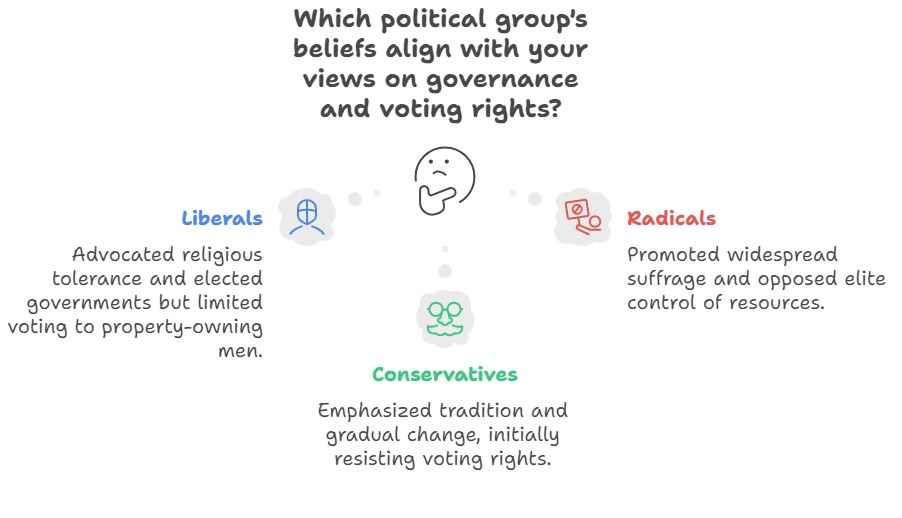
🌱 How Did Colonies Like India React?
The French Revolution’s ideas didn’t stay in Europe! Indian thinkers like Henry Derozio and Raja Rammohan Roy asked:
- “Why should only the rich have power?”
- “Can we mix European ideas with Indian traditions?”
Quote to Remember:
“A spark in France became a fire that lit up the world.”
Real-Life Connection:
Think of how K-pop fans in India mix Korean music with Bollywood dance moves. Colonies did the same—blending foreign ideas with local culture! 💃🎶
❓ Quick Quiz: Test Your Knowledge!
MCQs:
- Who said, “Let’s stick to old classics!”?
a) Radicals
b) Liberals
c) Conservatives - Which Indian reformer fought against Sati?
a) Derozio
b) Raja Rammohan Roy
c) Tipu Sultan
Assertion & Reason:
A: Liberals wanted voting rights only for educated men.
R: They believed education made people responsible.
Short Questions:
- Name one way colonies influenced European ideas.
- What’s the Latin root of the word “liberal”?
(Answers: 1-c, 2-b / A & R both true / 1-Added local perspectives, 2-“Liber”)
🚀 From Ideas to Action: The Russian Revolution!
All these debates led to a HUGE event: the Russian Revolution (1917). Radicals here tried to create a society where workers and peasants had power—this was called socialism.
Why socialism Matters:
- Socialism became a superpower of ideas in the 1900s.
- It showed the world that ordinary people could challenge kings and factory owners.
Real-Life Connection:
Remember when delivery workers during COVID-19 lockdowns protested for better pay? That’s exactly what Russian workers did in 1917—they said, “Our labor matters!” 🛵💪
🤯 Wait, Terms Change Over Time?
Words like “liberal” or “conservative” don’t mean the same today!
- Example: A 19th-century liberal might not support today’s LGBTQ+ rights.
Real-Life Connection:
Ever argued with your parents about slang? Like how “lit” used to mean “on fire” but now means “awesome”? Words evolve, just like political ideas! 🔥📱
🌟 Recap Cheat Sheet
- French Revolution = Start of “equality for all” debates.
- Conservatives = Slow change. Liberals = Moderate change. Radicals = Total overhaul!
- Colonies like India added their own ideas to the mix.
- Russian Revolution = First big test of socialism.
Did You Know?
Raja Rammohan Roy knew over 10 languages! He used his skills to spread ideas of justice. 🕊️
Real-Life Connection:
Think of Greta Thunberg—a teen who shook the world with climate activism. Roy was like the 19th-century Greta, using his voice for change! 🌍✊
💬 Let’s Chat!
- If you were in 19th-century Europe, would you be a conservative, liberal, or radical? Why?
- How do you think society should change today? (Climate action? Better schools?)
Psst… Next up: The Russian Revolution—where hungry people, angry workers, and a “no more Tsar!” chant changed history. 🥖✨
🧐 Liberals, Radicals, Conservatives: Who Wanted What?
Liberals: “Change, But Only for Some!”
Imagine if only people with college degrees could vote today. That’s how liberals in the 1800s thought!
- What They Wanted:
- A nation that tolerates all religions (big deal back then—most countries favored one religion, like Britain’s Church of England!).
- Elected governments with laws enforced by fair courts.
- Rights for individuals against powerful rulers.
- But Wait…:
- They didn’t support voting rights for all! Only men who owned property could vote.
- No votes for women 🙅♀️.
Real-Life Connection:
Ever heard debates about “Should only taxpayers vote?” Liberals had similar logic—they thought property owners made “smarter” choices!
Radicals: “Let’s Share Power—For Everyone!”
Radicals were like the TikTok activists of the 19th century—they wanted big changes!
- What They Fought For:
- Governments should represent most people, not just the rich.
- Supported women’s right to vote (suffrage).
- Hated that a few elites owned all land and factories.
- Fun Twist:
- They weren’t against private property—just hated it being hoarded by a handful of people.
Quote to Think About:
“Why should 1% control 99%?” — A radical protester in 1848.
Conservatives: “Slow Down—Respect the Past!”
Picture your grandpa saying, “Back in my day, things were better!” That’s conservatives at first!
- Originally:
- Against all change. (“If it’s worked for 100 years, why fix it?”)
- After French Revolution:
- “Okay, fine—some change is needed… but SLOWLY!”
- Wanted to preserve traditions while making tiny adjustments.
Real-Life Connection:
Ever seen older people hesitant about smartphones? Conservatives felt the same about democracy—it was too new and scary! 😅
📊 Quick Comparison Table
| Group | Key Beliefs | Voting Rights |
|---|---|---|
| Liberals | Religious tolerance, elected government | Property-owning men only 🧔💼 |
| Radicals | Power to the majority, women’s rights | All men (some wanted women too!) 👨👩 |
| Conservatives | Change = slow, respect traditions | Initially against voting rights! 🐢 |
❓ Quiz Time!
MCQs:
- Who wanted voting rights only for property-owning men?
a) Radicals
b) Conservatives
c) Liberals - Which group supported women’s suffrage?
a) Liberals
b) Radicals
c) Conservatives
Assertion & Reason:
A: Radicals disliked wealthy factory owners.
R: They believed property should be shared more equally.
(Are both true? Does R explain A?)
Short Questions:
- Why did liberals oppose universal adult franchise?
- How did conservatives’ views evolve after the French Revolution?
(Answers: 1-c, 2-b / Both A & R are true / 1-They thought only educated/property owners deserved it, 2-They accepted slow change)
🌪️ Clash of Ideas!
After the French Revolution, these groups collided like fans arguing over Marvel vs. DC!
- Liberals vs. Radicals: “How much change is too much?”
- Conservatives vs. Everyone: “Slow down!”
Did You Know?
These debates shaped revolutions in 1848—called the “Springtime of Nations”—where people across Europe rebelled for rights!
💬 Let’s Debate!
- If you were a worker in 19th-century Europe, which group would you join? Why?
- Think: Are today’s political parties (like Democrats/Republicans) similar to liberals, radicals, or conservatives?
Up Next: How did these fiery debates lead to the Russian Revolution? 🚩
🏭 Industrial Society & Social Change: Factories, Chaos, and New Ideas!
1. The Industrial Revolution: Machines Changed Everything!
Imagine your town suddenly exploding with factories, smoke, and trains chugging everywhere! That’s what happened in the 1800s.
- What Changed?
- New Cities: Like mushrooms after rain! (Example: Manchester, London).
- Factories: Men, women, and kids worked 14-hour days for pennies. 😓
- Problems: Dirty slums, no sanitation, unemployment when demand dropped.
Real-Life Connection: Ever seen crowded metro stations during rush hour? Industrial cities were 10x worse—no AC, just sweat and coal dust!
2. Liberals & Radicals: “We Need Solutions… But How?”
Even liberals/radicals (who owned factories!) were worried. Their ideas:
- Education & Health: “If workers are healthy and educated, they’ll make us richer!”
- Freedom for All? Well… not really. They still wanted:
- No Birth Privileges: “Don’t let nobles rule just because they’re born rich!”
- Let Capitalism Grow: “If the rich invest freely, everyone benefits!”
Fun Fact: Some liberals cared about workers but also owned factories. Talk about mixed feelings!
3. Workers’ Lives: “Why Are We Suffering?”
- Wages: So low that families starved even if everyone worked.
- Housing: 10 people crammed in one room (no windows!).
- Disease: Cholera outbreaks killed thousands.
Quote to Remember: “Workers of the world, unite! You have nothing to lose but your chains!” — Karl Marx (but we’ll get to him later!).
📊 Industrial Problems vs. Solutions
| Problems | Liberal/Radical Solutions | But… |
|---|---|---|
| Long hours, low wages | Improve education & healthcare | Workers still had no voting rights! |
| Overcrowded cities | Build better housing (slowly…) | Profit came first for factory owners |
| Unemployment | Let the market decide | No welfare or job security! |
4. Nationalists Join the Fight: “Revolution Time!”
By 1815, folks were fed up with kings and inequality. Nationalists like Giuseppe Mazzini (Italy) said:
- “Let’s overthrow monarchs and create nations where ALL have equal rights!”
- India Connection: Indian nationalists read Mazzini’s writings and thought, “Hey, we can do this too!” 🇮🇳
Did You Know? Mazzini was exiled three times for plotting revolutions. Rebel spirit! ✊
❓ Quick Quiz: Test Your Brain!
MCQs:
- Who worked in factories during the Industrial Revolution?
a) Only men
b) Men, women, and children
c) Robots - What did liberals think would improve society?
a) More royal privileges
b) Education and healthcare
c) Longer work hours
Assertion & Reason:
A: Liberals opposed old aristocrats’ birth privileges.
R: They believed success should come from hard work, not birth.
(Are both true? Does R explain A?)
Short Questions:
- Name one problem in industrial cities.
- Why did nationalists like Mazzini want revolutions?
(Answers: 1-b, 2-b / Both A & R true / 1-Overcrowding or disease, 2-To create equal nations)
🌪️ Why Did Workers Get Angrier?
Liberals/radicals had ideas, but workers were tired of waiting! Imagine working 14 hours and still not affording bread. 😤
- Result: Protests, strikes, and… secret societies plotting revolutions!
Real-Life Connection: Ever seen fast-food workers strike for $15/hour? Same energy, 200 years later! 🍔✊
🌟 Recap Cheat Sheet
- Industrial Revolution = Factories, cities, and chaos!
- Liberals/Radicals = Wanted educated workers & capitalism, but no votes for poor.
- Nationalists = Dreamed of equal nations through revolutions.
- Workers = Suffered, protested, and sought CHANGE.
💬 Let’s Debate!
- If you were a factory owner in 1800s, would you support workers’ rights? Why/why not?
- Think: How is today’s gig economy (Uber, Swiggy) similar to industrial-era jobs?
Psst… What if workers owned the factories themselves? That’s what SOCIALISM promised! Next up: How Karl Marx’s ideas lit a fire across Europe… and why some loved it, while others panicked! 🔥📖
🌟 What is Socialism? The Big Idea!
Imagine if your class owned a pizza together, and everyone got a fair slice—not just the kid who brought it. Socialism was like that!
- Problem: Socialists saw private property (factories, land) as the root of all evil. Why?
- Factory owners got rich, while workers slaved for pennies.
- Solution: “Let society own property, not individuals! Then everyone benefits.”
Real-Life Connection: Ever seen a community garden where everyone grows veggies together? That’s socialism in action! 🌱
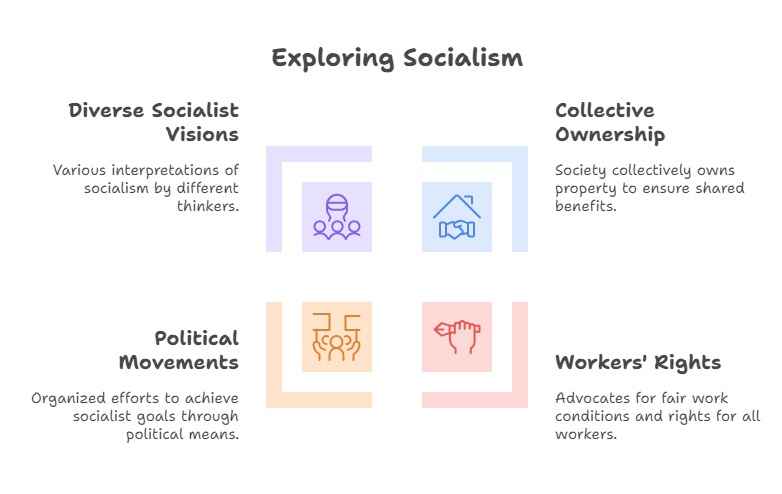
🤔 Socialists Had Different Dreams…
Not all socialists agreed on how to fix society:
| Socialist | Vision | Real-Life Example |
|---|---|---|
| Robert Owen | Build a utopia called “New Harmony” in the USA 🌈 | Like starting a commune where everyone shares chores! |
| Louis Blanc | “Governments should fund co-ops!” 🇫🇷 | Similar to govt. supporting worker-run cafes today. |
| Karl Marx | “Workers! Revolt against capitalists!” 💥 | Imagine if Zomato delivery riders owned the app! |
Marx’s Warning:
- Capitalists (factory owners) steal workers’ profits.
- Workers must overthrow them to create a communist society (no private property, all shared!).
Fun Fact: Marx’s book Das Kapital is thicker than your math textbook—but way more dramatic! 📚🔥
✊ Workers Unite! Socialism Spreads
By the 1870s, socialism went viral in Europe:
- Workers’ Clubs: Like WhatsApp groups for strikes! Demanded:
- 8-hour workdays (not 14!).
- Voting rights for workers.
- Emergency funds for sick members.
- Political Parties:
- Germany: Social Democratic Party (SPD).
- Britain: Labour Party.
- France: Socialist Party.
But… Even by 1914, socialists never formed a govt. in Europe. Conservatives/liberals still ruled!
Real-Life Connection: Ever seen unions strike for better pay? That’s socialism’s legacy! ✊
❓ Quick Quiz: Are You a Socialist?
MCQs:
- Who said workers should revolt against capitalists?
a) Robert Owen
b) Karl Marx
c) Louis Blanc - What did Louis Blanc want governments to do?
a) Ban all factories
b) Fund co-ops (Answer: b)
c) Lower taxes
Assertion & Reason:
A: Socialists opposed private property.
R: They believed it caused inequality.
(Are both true? Does R explain A?)
Short Questions:
- Name one socialist from the 1800s.
- What is a communist society?
(Answers: 1-b, 2-b / Both A & R true / 1-Owen, Blanc, or Marx / 2-Property owned by society)
🚩 Why Did Socialism Matter?
- Workers Got Hope: “We deserve better!”
- New Laws: Even conservative govts. passed labour laws (like weekend holidays!) to calm protests.
Quote to Remember:
“Workers of the world, unite; you have nothing to lose but your chains!” — Karl Marx
Did You Know? The Second International (socialist global group) was like the Avengers—but for workers! 🌍✨
💬 Let’s Debate!
- If you owned a factory, would you share profits with workers? Why/why not?
- Think: Is “equal pay for all” fair? What if someone works harder?
🌪️ From Ideas to Explosion: The Russian Revolution!
Socialism was just a theory… until Russia tried it! But wait:
- Why did workers and peasants in Russia rebel?
- How did a guy named Lenin turn Marx’s ideas into reality?
- Spoiler: It wasn’t all sunshine and rainbows. 🌧️
Teaser: Imagine if your school’s lunch system was run by students—would it be chaos or paradise? Russia’s revolution asked the same! 🍞⚔️
Up Next: The Russian Revolution—where hungry crowds, radical slogans, and a shattered monarchy changed history forever!
🌍 The Russian Empire in 1914: A Giant Puzzle!
Imagine a country so big it stretched from Europe to the Pacific Ocean! Tsar Nicholas II ruled this massive empire:
- Included: Finland, Poland, Ukraine, Central Asia, and more!
- Religions: Mostly Russian Orthodox Christians, but also Muslims, Buddhists, and Catholics.
Fun Fact: Russia was like a human-sized map—today’s 14 countries were part of it! 🗺️
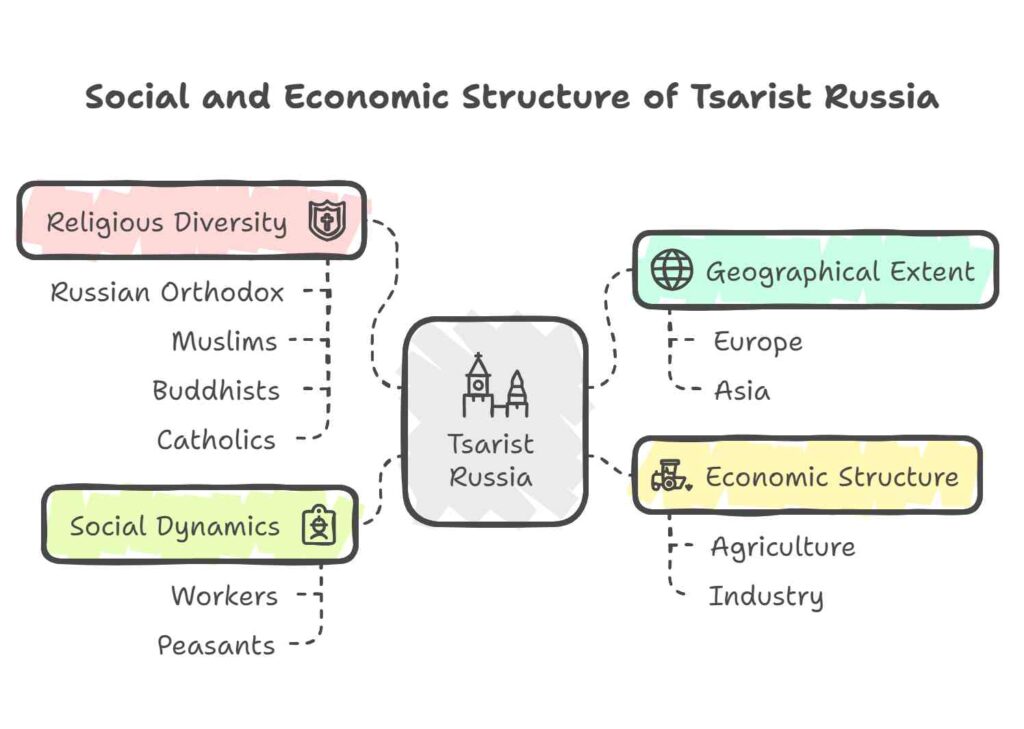
🌾 Economy & Society: Farmers Rule!
Agriculture:
- 85% of Russians were farmers (vs. 40-50% in France/Germany).
- Peasants grew food for themselves and exported grain worldwide.
Industry:
- Factories popped up in cities like St. Petersburg and Moscow.
- Workers’ Lives:
- 15-hour workdays in small workshops 😴.
- Women earned half of men’s wages! 💔
Real-Life Connection:
Think of Russia as a pizza—85% was farmers, 15% workers. Europe? More like a half-pizza! 🍕
📊 Russia vs. Europe: Who Worked More?
| Country | % Farmers | Factory Hours |
|---|---|---|
| Russia | 85% | 10-15 hrs/day |
| France | 40% | 10-12 hrs/day |
| Germany | 50% | 10-12 hrs/day |
👷 Workers: Divided but Angry!
Workers were split like school cliques:
- Skill Groups: Metalworkers (the “cool kids”) vs. textile workers.
- Village Ties: Some workers went home during harvest; others stayed in cities.
Quote Alert:
“Metalworkers thought they were kings! They had skills, we had blisters.” — A textile worker, 1905.
Strikes:
- 1896-1897: Textile workers protested for better pay.
- 1902: Metalworkers joined the fight! 🔥
👨🌾 Peasants: “We Want Land, Not Lords!”
- Nobles: Owned most land but were hated (unlike France!).
- Peasant Demands:
- “Give us nobles’ land!”
- Refused to pay rent; even killed landlords!
Real-Life Connection:
Ever played Monopoly where one player owns all hotels? Peasants wanted to reset the game! 🎲
Did You Know?
In 1905, peasants revolted nationwide—burning manors like TikTok challenges go viral! 📱🔥
🌱 The Mir System: Sharing is Caring?
Russian peasants had a unique tradition:
- Communal Land: Villages pooled land and split it fairly among families.
- Why?: To survive harsh winters and poor soil.
Think Deeper:
Is this like splitting group project work equally—even if someone slacks off? 🤔
❓ Quick Quiz: Test Your Tsar Knowledge!
MCQs:
- What % of Russians were farmers in 1914?
a) 40%
b) 85%
c) 15% - Why did peasants hate nobles?
a) Nobles were TikTokers
b) Nobles owned all land (Answer: b)
c) Nobles loved cats
Assertion & Reason:
A: Workers struck frequently in the 1890s.
R: They wanted shorter hours and better pay.
(Are both true? Does R explain A?)
Short Questions:
- Name one industrial city in Russia.
- What was the mir system?
(Answers: 1-b, 2-b / Both A & R true / 1-St. Petersburg or Moscow / 2-Communal land sharing)
💥 Why Did Russia Explode?
- Farmers: Hungry for land.
- Workers: Exhausted and underpaid.
- Tsar Nicholas II: Clueless, living in a palace bubble!
Quote to Remember:
“A revolution is impossible until it becomes inevitable.” — Leon Trotsky
🌟 Recap Cheat Sheet
- Russian Empire: Huge, multi-religious, farming-based.
- Workers: Divided but united in strikes.
- Peasants: Hated nobles, revolted for land.
- Mir System: Fair sharing (but not always fair!).
🌪️ What’s Next? Socialism in Russia!
But wait—how did angry peasants and workers turn into revolutionaries?
- Spoiler: Lenin and Marx team up like superheroes!
- “Peace, Land, Bread!” became the battle cry. 🍞⚔️
Teaser: Imagine if your school cafeteria was run by students—would it be chaos or utopia? Russia’s socialists tried to find out!
Up Next: Socialism in Russia—where strikes turn into revolutions, and the Tsar’s crown starts to wobble! 👑💥
🌟 Socialism in Russia: Secret Clubs & Peasant Power!
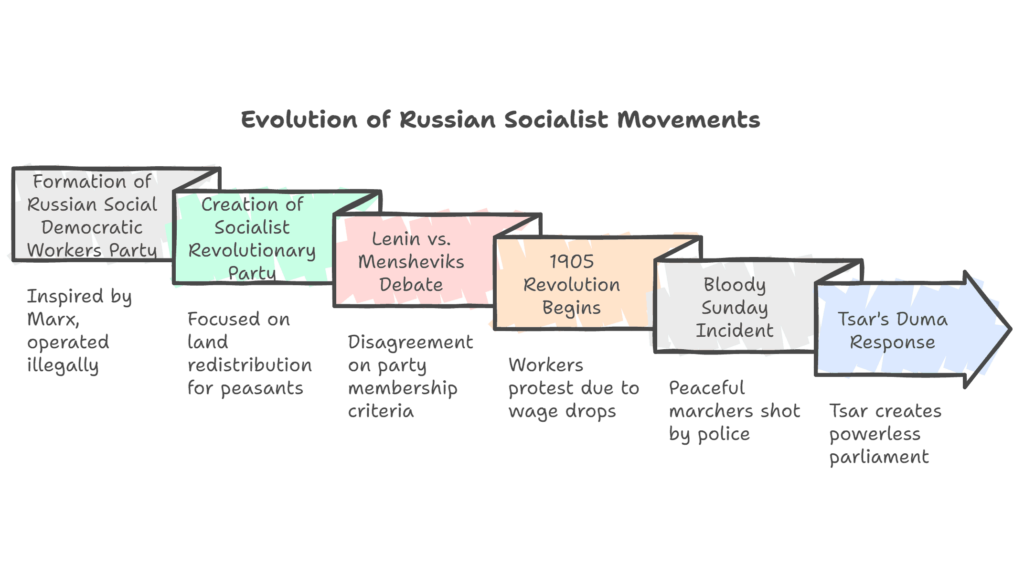
1. Underground Socialist Parties
Imagine starting a secret club because the government banned all parties! That’s what Russian socialists did:
- Russian Social Democratic Workers Party (1898):
- Inspired by Karl Marx.
- Operated illegally—published secret newspapers, organized strikes.
- Socialist Revolutionary Party (1900):
- Focused on peasants: “Give nobles’ land to the poor!” 🌾
Fun Fact: These parties were like real-life spy movies—members used code names and met in hidden locations! 🕵️♂️
2. Lenin vs. Mensheviks: “Who Can Join the Party?”
Socialists disagreed on how to fight the Tsar:
| Group | Leader | Strategy |
|---|---|---|
| Bolsheviks | Vladimir Lenin | “Only loyal, disciplined members!” 🧨 |
| Mensheviks | Julius Martov | “Let everyone join—bigger the better!” 🌍 |
Lenin’s Argument: “Peasants aren’t all poor! Some hire workers—they’re mini-capitalists!”
Real-Life Connection:
Think of a school project group: some want only A+ students (Lenin), others say “Let all join!” (Mensheviks).
🌪️ The 1905 Revolution: Bloody Sunday & Broken Promises
3. Why Did Workers Explode?
- 1904: Prices skyrocketed—workers’ wages dropped by 20%!
- Strike at Putilov Iron Works: 110,000 workers in St. Petersburg protested for:
- 8-hour workdays (down from 15!).
- Better pay.
- Safer factories.
Bloody Sunday (Jan 1905):
- Workers marched peacefully to the Tsar’s palace, led by priest Father Gapon.
- Result: Police shot 100+ dead, 300+ wounded. 💔
Real-Life Connection:
Like when people march for climate action—but met with violence instead of change. 🌍✊
4. Tsar’s Fake Fix: The Duma
After protests, Tsar Nicholas II pretended to listen:
- Created the Duma: A “parliament” with no real power.
- Shut it down: First Duma dismissed in 75 days, second in 3 months!
- Third Duma: Packed with conservative yes-men.
Quote Alert:
“The Tsar gave us a toy democracy—then broke it!” — A frustrated liberal, 1906.
📊 1905 Revolution: Winners vs. Losers
| Group | Demands | Outcome |
|---|---|---|
| Workers | 8-hour day, higher wages | Temporary strikes, no real change 😞 |
| Peasants | Land redistribution | Tsar ignored them 🚜 |
| Middle Class | Constitution, civil rights | Duma became a joke 🎭 |
❓ Quick Quiz: Test Your Rebel Knowledge!
MCQs:
- Who led the Bolsheviks?
a) Julius Martov
b) Vladimir Lenin
c) Father Gapon - What triggered Bloody Sunday?
a) A workers’ protest march
b) A peasant revolt
c) A socialist party meeting
Assertion & Reason:
A: The Tsar’s Duma had no real power.
R: He dismissed it whenever it questioned him.
(Are both true? Does R explain A?)
Short Questions:
- Name one socialist party in Russia.
- Why did workers strike in 1904?
(Answers: 1-b, 2-a / Both A & R true / 1-Social Democrats or Socialist Revolutionaries / 2-Wages fell 20%)
💥 Why Did the 1905 Revolution Fail?
- Tsar’s Tricks: Fake reforms, broken promises.
- Divided Protesters: Workers, peasants, and liberals didn’t unite.
- No Army Support: Soldiers stayed loyal to the Tsar.
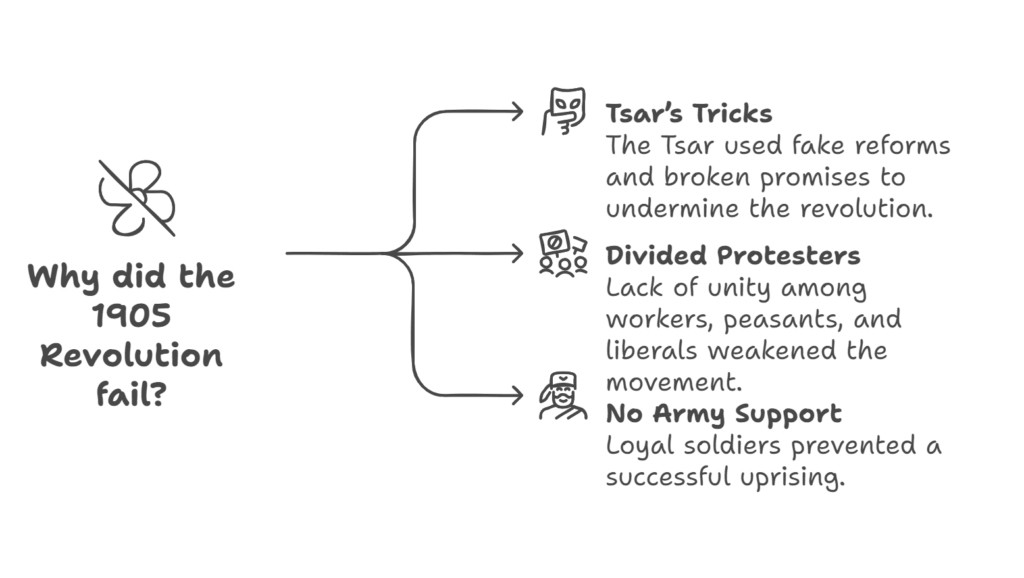
Did You Know?
The 1905 Revolution was like a dress rehearsal for 1917—it showed the Tsar’s weakness!
🌟 Recap Cheat Sheet
- Socialist Parties: Operated illegally; split into Bolsheviks/Mensheviks.
- 1905 Revolution: Bloody Sunday sparked nationwide protests.
- Tsar’s Response: Fake parliament (Duma), crushed dissent.
- Legacy: Set the stage for the 1917 Revolution!
🔥 What’s Next? WWI Breaks Russia!
But wait—how did a World War push Russia into chaos?
- Spoiler: Soldiers freezing without boots, peasants starving, and the Tsar’s final mistake! ❄️💣
Teaser: Imagine your school cafeteria runs out of food and heating in winter. That’s Russia in 1914—war made everything worse!
Up Next: The First World War and the Russian Empire—where trenches, hunger, and a doomed Tsar collide! ⚔️🍞
🌍 World War I Ignites: A Global Firestorm!
In 1914, Europe split into two rival gangs:
- Central Powers: Germany, Austria, Turkey.
- Allies: France, Britain, Russia (later Italy/Romania).
Imagine a schoolyard brawl that went global—fighting spread from Europe to Africa and Asia!
Real-Life Connection: Like TikTok trends, the war went viral—soldiers from India, Canada, and Senegal joined too! 🌏

Russia Joins the Fight: “For the Tsar!”… At First
Initially, Russians rallied behind Tsar Nicholas II like fans at a soccer match! ⚽ But soon:
- Tsar’s Mistakes: Ignored advice, let his German-born wife (Tsarina Alexandra) and the creepy “mad monk” Rasputin rule.
- Anti-German Rage: Even renamed St. Petersburg to Petrograd (too German-sounding!).
Fun Fact: Rasputin survived poison, bullets, and drowning before finally dying. Talk about a real-life horror movie! 😱
⚔️ Eastern Front Chaos: No Trenches, Just Turmoil!
Western Front (France): Armies dug trenches and stayed put. 🕳️
Eastern Front (Russia):
- Huge battles with 7 million casualties by 1917.
- Russian retreats = “Scorched earth” policy. Burned crops, left 3 million homeless! 🌾🔥
Real-Life Connection: Like a video game where you destroy everything so the enemy can’t use it—except real people suffered. 🎮💔
🏭 Home Front Horror: Factories Fail, Hunger Spreads
- Industry Collapsed: Few factories + German blockades = No tools or parts. 🛠️
- Labor Shortage: Men sent to war. Workshops closed.
- Bread Riots: By 1916, cities starved. Imagine your cafeteria running out of pizza—but it’s your only food! 🍞😡
Quote Alert: “We’re drowning in mud, blood, and hunger!” — A Russian soldier’s letter, 1916.
📉 Tsar’s Downfall: “We’re Done With You!”
- Army Morale Crashed: Soldiers refused to fight.
- Refugees + Hunger = Blamed the Tsar.
- 1916 Winter: Riots at bakeries became daily.
Did You Know? Russia’s trains broke down so much, troops got stuck in snowstorms! ❄️🚂
❓ Quick Quiz: War Woes
MCQs:
- Why did Russians rename St. Petersburg?
a) To honor the Tsar
b) Anti-German feelings
c) It sounded cooler - What policy destroyed Russian crops?
a) Scorched earth
b) Organic farming
c) Crop rotation
Assertion & Reason:
A: The Tsar lost support during WWI.
R: He ignored the Duma and let Rasputin rule.
(Are both true? Does R explain A?)
Short Questions:
- Name one country in the Central Powers.
- Why did bread riots erupt in cities?
(Answers: 1-b, 2-a / Both A & R true / 1-Germany, Austria, or Turkey / 2-Flour shortages)
🌟 Recap Cheat Sheet
- WWI Alliances: Russia vs. Germany/Austria/Turkey.
- Eastern Front: Mobile battles, scorched earth, millions dead.
- Home Crisis: Factories failed, cities starved, Tsar clueless.
- Result: Riots, rage, and a Tsar on thin ice!
🔥 What’s Next? The February Revolution!
How did hungry protests in Petrograd become a full-blown revolution?
- Spoiler: Women led the charge, soldiers switched sides, and the Tsar’s throne shattered! 👑💥
Teaser: Imagine your school cafeteria riot leading to the principal resigning—that’s Petrograd in 1917! 🥖✊
Up Next: The February Revolution—where bread strikes snowball into history’s most explosive revolt!
🥶 February 1917: Petrograd’s Freezing Fury!
Imagine a city split by a river:
- Right Bank: Smoky factories, slums, hungry workers. ❄️
- Left Bank: Glittering palaces, the Tsar’s Winter Palace, and politicians in the Duma.
By February, workers were starving, frostbite was common, and the Tsar still wanted to shut down the Duma!
Real-Life Connection: Like your school’s “rich kids” side vs. “everyone else”—but with -30°C temps!
👩🏭 Women Lead the Charge: “We Want Bread!”
22 February: Workers at a factory were locked out.
23 February: 50 factories went on strike—women marched first, shouting:
- “Bread for our children!”
- “Down with the Tsar!”
Fun Fact: This day became International Women’s Day! 👑💪
💥 From Protests to Uprising: The Tsar Panics!
- 25 February: Tsar orders soldiers to shoot protesters.
- 26 February: Crowds swarm left bank streets.
- 27 February: Game Changer: Soldiers refuse to fire on people. Instead, they join them!
Quote Alert:
“Why shoot our own brothers? We’re all starving!” — A mutinying soldier.
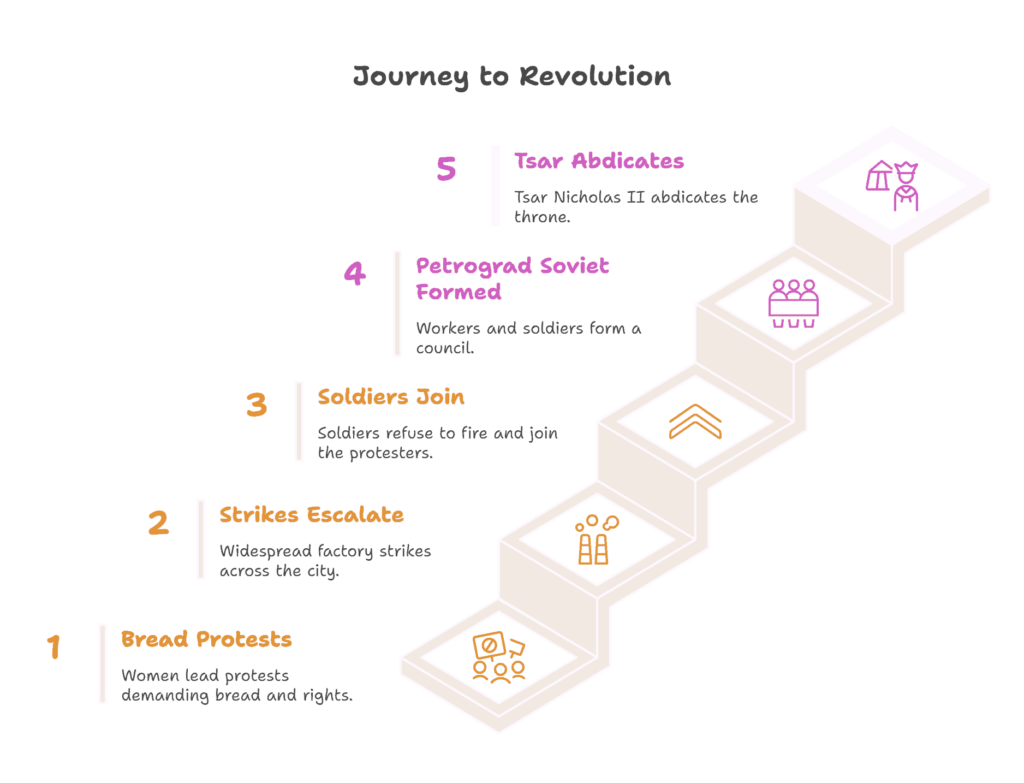
🏛️ Birth of the Petrograd Soviet: Workers Take Power!
Striking workers + rebel soldiers = Petrograd Soviet (a council) formed in the Duma building!
- Demands:
- End the war.
- Redistribute land.
- 8-hour workday.
Real-Life Connection: Like your class forming a student council to overthrow a strict principal! 🎓✊
👑 Tsar’s Final Bow: “I Quit!”
2 March 1917: Tsar Nicholas II is begged by his own generals to abdicate (quit). He signs away his throne—300 years of Romanov rule ends!
Did You Know? The Tsar wrote in his diary that day: “Just played dominoes. Feeling unwell.” Clueless till the end! 😑
❓ Quick Quiz: Revolution Recap!
MCQs:
- Who led the first strikes in February?
a) Soldiers
b) Women (Answer: b)
c) Politicians - What was the Petrograd Soviet?
a) A royal palace
b) A workers’ council (Answer: b)
c) A new law
Assertion & Reason:
A: Soldiers refused to shoot protesters.
R: They sympathized with workers’ demands.
(Are both true? Does R explain A?)
Short Questions:
- Name one demand of the protesters.
- Why did the Tsar abdicate?
(Answers: 1-Bread/Wages/Democracy, 2-Military pressured him)
🌟 Recap Cheat Sheet
- Petrograd Divided: Workers vs. elites.
- Women’s Strike: Sparked revolution on International Women’s Day.
- Soldiers Mutiny: Refused orders, joined protesters.
- Tsar Abdicates: Romanov rule ends; Provisional Government takes over.
🌪️ After February: Now What?
The Provisional Government promised democracy… but:
- Should Russia stay in WWI?
- Will peasants get land?
- Who’s really in charge—the government or the Soviets?
Teaser: Imagine your class overthrows the principal… but then argues over how to run the school. Chaos? New leaders? Lenin is waiting in the wings! ⚒️🔥
Up Next: After February—where freedom turns messy, and the Bolsheviks plot their big move!
🏛️ The Provisional Government: Democracy or Disarray?
After the Tsar quit, Russia was run by a Provisional Government mixed with liberals and socialists. But power was shaky:
- Who Held Power?: Army generals, factory owners, and nobles. 🎖️🏭
- Promises: Elections, free speech, and lifted bans on protests.
- Problem: Soviets (workers’ councils) also gained power—like rival student councils fighting over school rules!
Real-Life Connection: Imagine your class splits into two groups to plan a party—chaos guaranteed! 🎉
📜 Lenin’s Big Return: “Peace, Land, Bread—NOW!”
In April 1917, Vladimir Lenin (in disguise!) returned from exile with a bombshell plan:
- April Theses:
- End WWI immediately!
- Give land to peasants!
- Nationalize banks! 💰
- Rebrand Alert: Lenin wanted the Bolsheviks renamed Communist Party for a fresh start.
Fun Fact: Lenin used fake passports and a wig to sneak into Russia—like a spy movie! 🕶️
🤯 Even Bolsheviks Were Shocked!
Most Bolsheviks thought: “Whoa, Lenin! It’s too soon for revolution!” They wanted to support the Provisional Government …
But by summer 1917:
- Workers formed factory committees to boss around industrialists.
- Soldiers created army committees (no more blind obedience!).
- Peasants seized nobles’ land—3 months, 90% of estates redistributed! 🌾
📊Provisional Government vs. Soviets: Who’s the Boss?
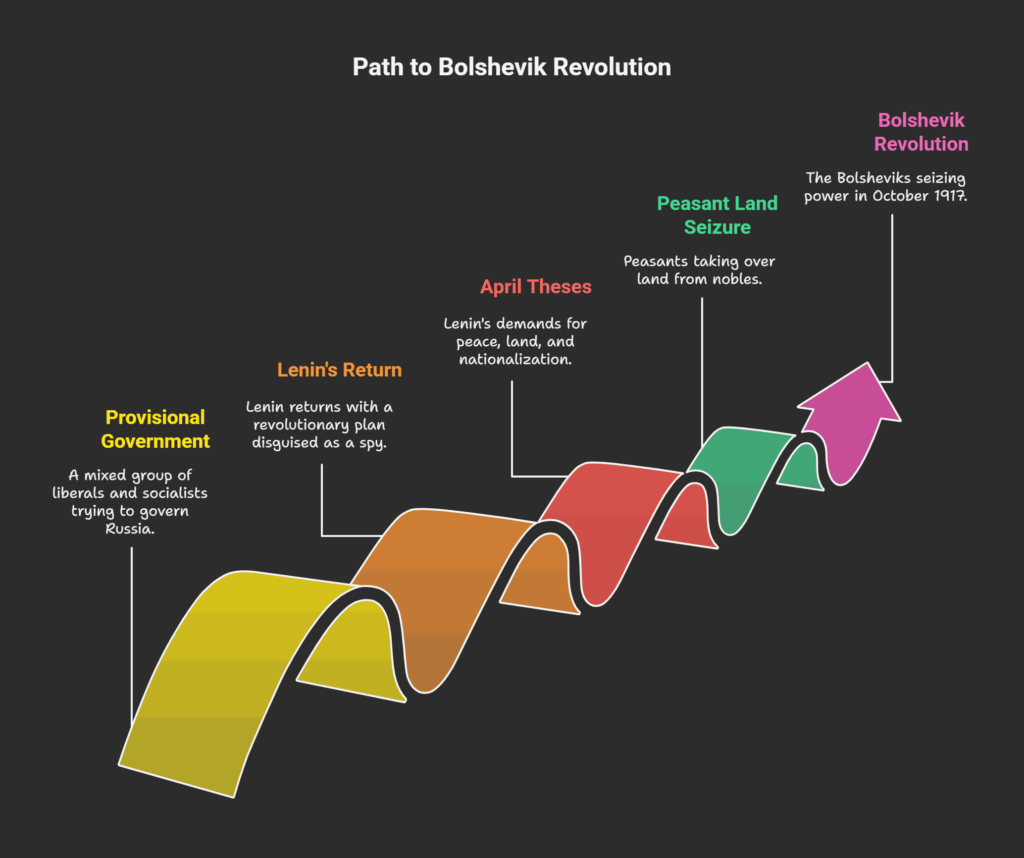
| Provisional Government | Soviets (Workers’ Councils) |
|---|---|
| Led by elites, kept Russia in WWI 🎩 | Demanded peace, land reform ✊ |
| Arrested罢工 leaders 🔒 | Backed by workers, soldiers, peasants 🔥 |
| Losing control by July 1917 📉 | Gaining power daily 📈 |
☠️ July Crackdown: Bolsheviks Go Underground
In July, the Provisional Government struck back:
- Arrested Bolshevik leaders.
- Crushed protests with force.
- Lenin fled to Finland, hiding in a haystack! 🚜
Quote Alert: “Sometimes you retreat… to leap forward.” — Lenin, plotting his comeback.
🌾 Peasants Revolt: “Land is Ours!”
While cities burned, villages rebelled:
- Socialist Revolutionaries encouraged peasants to grab land.
- Land Committees divided estates—no more landlords!
Real-Life Connection: Like squatters taking over an empty mall and turning it into farms! 🛒→🌱
❓ Quick Quiz: After February Frenzy!
MCQs:
- What did Lenin demand in his April Theses?
a) More war
b) Nationalize banks (Answer: b)
c) Bring back the Tsar - Why did peasants form Land Committees?
a) To grow roses
b) Redistribute nobles’ land (Answer: b)
c) Build factories
Assertion & Reason:
A: The Provisional Government arrested Bolsheviks in July 1917.
R: They feared losing power to the Soviets.
(Are both true? Does R explain A?)
Short Questions:
- Name one group in the Provisional Government.
- Why did Lenin flee to Finland?
(Answers: 1-Army officials/landowners/industrialists, 2-To avoid arrest)
🌪️ October’s Storm Clouds
By September 1917:
- Lenin: “Provisional Government” is weak—time to strike!” 💥
- Bolsheviks: Infiltrated armies, Soviets, and factories.
- Provisional Government : Clueless, still stuck in WWI.
Did You Know? The Bolsheviks had only 24,000 members in February—but 200,000 by October! 📈
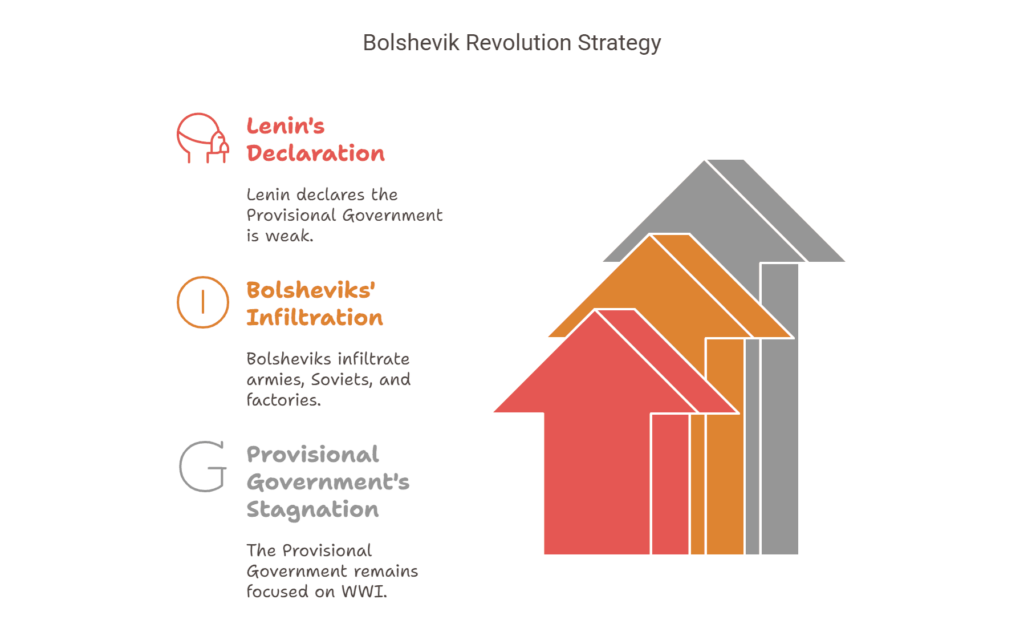
💬 Let’s Debate!
- If you were a peasant, would you seize land or wait for the government?
- Think: Is it better to reform slowly Provisional Government or revolt fast (Bolsheviks)?
🚩 Next Up: October 1917—The Bolshevik Strike!
The stage is set:
- Hungry workers ✅
- Armed Soviets ✅
- Lenin’s masterplan ✅
But… will the Bolsheviks win? Or will the Provisional Government crush them?
Teaser: Imagine your school’s quietest kid organizing a secret takeover of the principal’s office. That’s Lenin in October 1917. 😎
Coming Soon: The October Revolution—where whispers become roars, and history changes overnight! 🌙⚔️
🌟 The October Revolution: Lenin’s Midnight Masterstroke
1. “It’s Time to Strike!” – Lenin’s Secret Plan
Lenin, hiding in Finland, was done waiting. He secretly returned to Petrograd, yelling, “The Provisional Government is weak—let’s grab power NOW!”
- Plan: Use Soviets (workers’ councils), rebel soldiers, and factory workers to overthrow the government.
- Key Player: Leon Trotsky, head of the Military Revolutionary Committee, organized the attack like a military video game strategy! 🎮
Fun Fact: The revolution date was kept secret—even most Bolsheviks didn’t know! 🤫
2. October 24: The Midnight Takeover Begins!
- Prime Minister Kerenskii fled the city, sensing trouble (like a principal skipping school on prank day!).
- Pro-Government Troops: Tried seizing Bolshevik newspapers and the Winter Palace.
- Bolshevik Counterattack:
- Rebels stormed post offices, bridges, and railways.
- The battleship Aurora fired blanks at the Winter Palace—more noise than damage, but it scared everyone! 💥
- By dawn, the Winter Palace (symbol of Tsarist power) fell. Ministers surrendered while hiding in a back room!
Real-Life Connection: Imagine your class secretly planning to take over the school cafeteria—and pulling it off overnight! 🥪🔔
3. “We Won! Now What?” – Bolsheviks Take Charge
- All-Russian Congress of Soviets (filled with workers/soldiers) approved the takeover.
- Moscow Fights Back: Heavy gunfire for days, but Bolsheviks won by December.
- New Power: Lenin declared, “Workers, peasants, and soldiers—this is YOUR government now!”
Quote Alert:
“You don’t make revolutions with silk gloves.” — Joseph Stalin (later… but that’s another story!).
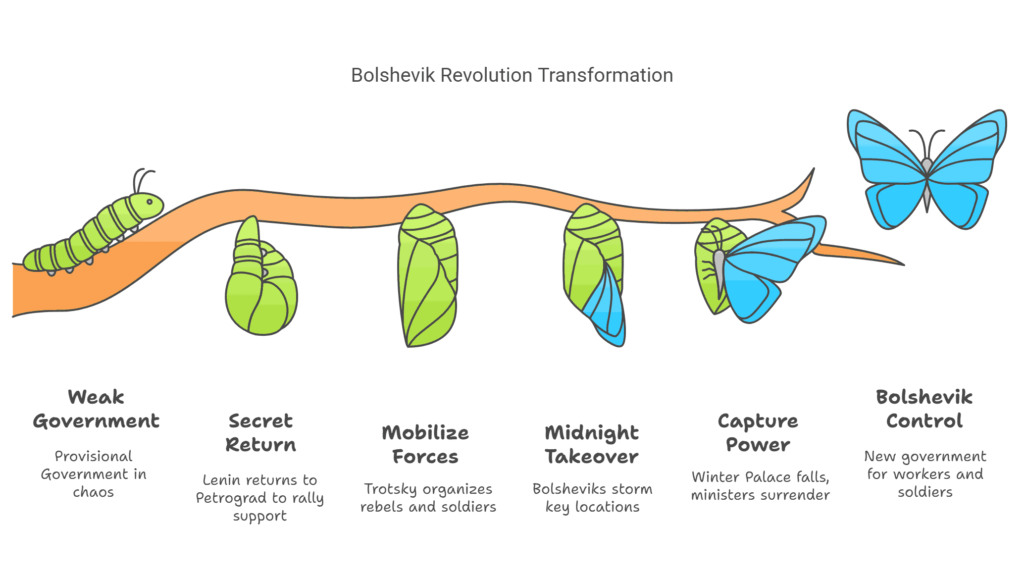
📊 Who Supported the Bolsheviks?
| Group | Role in Revolution |
|---|---|
| Factory Workers | Struck work, joined Red Guards |
| Soldiers | Refused to defend the government |
| Peasants | Distracted elites by seizing land |
❓ Quick Quiz: October Revolution Rumble!
MCQs:
- Who led the Military Revolutionary Committee?
a) Lenin
b) Trotsky
c) Kerenskii - What did the battleship Aurora do?
a) Sank the Winter Palace
b) Fired warning shots (Answer: b)
c) Transported Lenin
Assertion & Reason:
A: The Bolsheviks kept the revolution date secret.
R: They wanted to surprise the Provisional Government.
(✔️ Both true! R explains A.)
Short Questions:
- Name one place Bolsheviks captured on October 24.
- Why did Kerenskii flee Petrograd?
(Answers: 1-Winter Palace/post offices, 2-Feared Bolshevik uprising)
🌍 What Changed After October?
The Bolsheviks flipped Russia upside down:
- Banks & Factories: Nationalized! (Government took control.)
- Land: Given to peasants—no more nobles! 🚜
- Housing: Mansions split into communal apartments.
- Fashion: Old titles banned; new Soviet hats (budeonovka) became trendy! 🧢
Did You Know? The budeonovka hat was picked via a public contest—like Project Runway for revolutionaries! ✂️
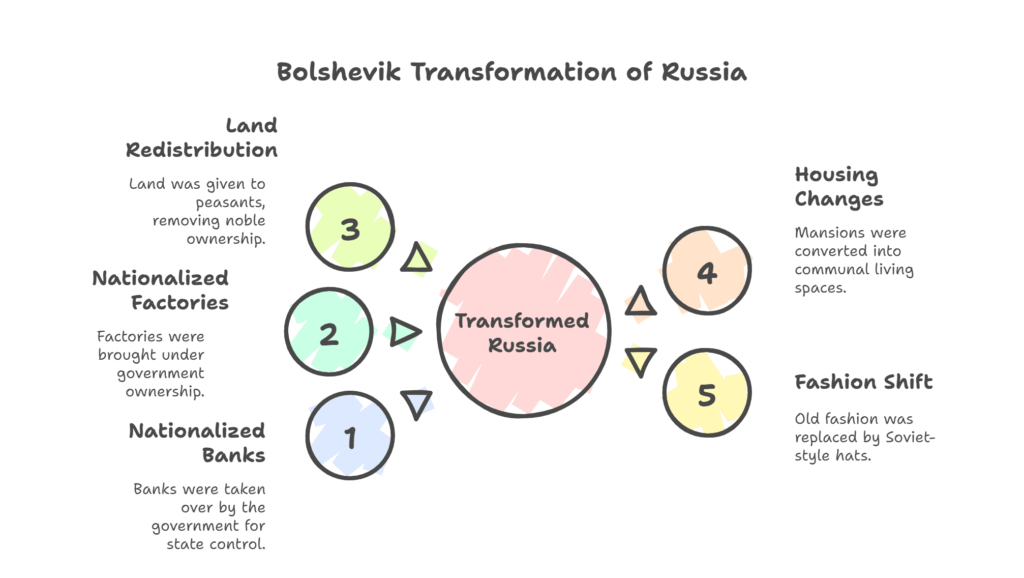
🚀 From Revolution to Radical Reforms…
But wait—how do you run a country with no rich elites?
- Spoiler: Civil war, food shortages, and a very angry world.
- Teaser: Imagine your school abolishing grades, uniforms, and homework—chaos or utopia? 📚💥
Next Up: What Changed After October?—where banks vanish, peasants cheer, and the world watches in shock!
🏭 What Changed After October? A New Russia Emerges!
1. Bye-Bye Private Property!
The Bolsheviks hit the reset button on Russia’s economy:
- Banks & Factories: Nationalized! The government took control 🏦🏭.
- Land Redistribution: Peasants grabbed nobles’ estates—no more landlords! 🌾
- Housing Revolution: Mansions split into tiny apartments for workers’ families 🏘️.
Fun Fact: The Bolsheviks held a fashion contest in 1918 to design new army hats. The winner? The budeonovka—a star-adorned winter cap! 🧢⭐
2. One-Party Rule Begins
- Name Change: Bolsheviks → Russian Communist Party.
- Election Drama: Lost the 1917 Constituent Assembly elections, so Lenin shut it down! 🗳️❌
- New “Parliament”: All Russian Congress of Soviets (filled with Bolshevik supporters).
Real-Life Connection: Imagine your school council gets replaced by a group that only lets their friends vote! 🏫🤨
3. Peace with Germany… At a Cost!
In March 1918, Russia signed the Treaty of Brest-Litovsk with Germany:
- Ended WWI for Russia.
- But lost huge territories (Ukraine, Baltic states).
Quote Alert: “To save the revolution, we must retreat.” — Lenin.
4. Crackdowns & Control
- Secret Police: Cheka (later NKVD) arrested critics—even whispering against the Party was risky! 👮♂️🔍
- Trade Unions: Puppets of the Party 🧸.
- Censorship: Artists faced limits—some rebelled, others quit. 🎨✂️
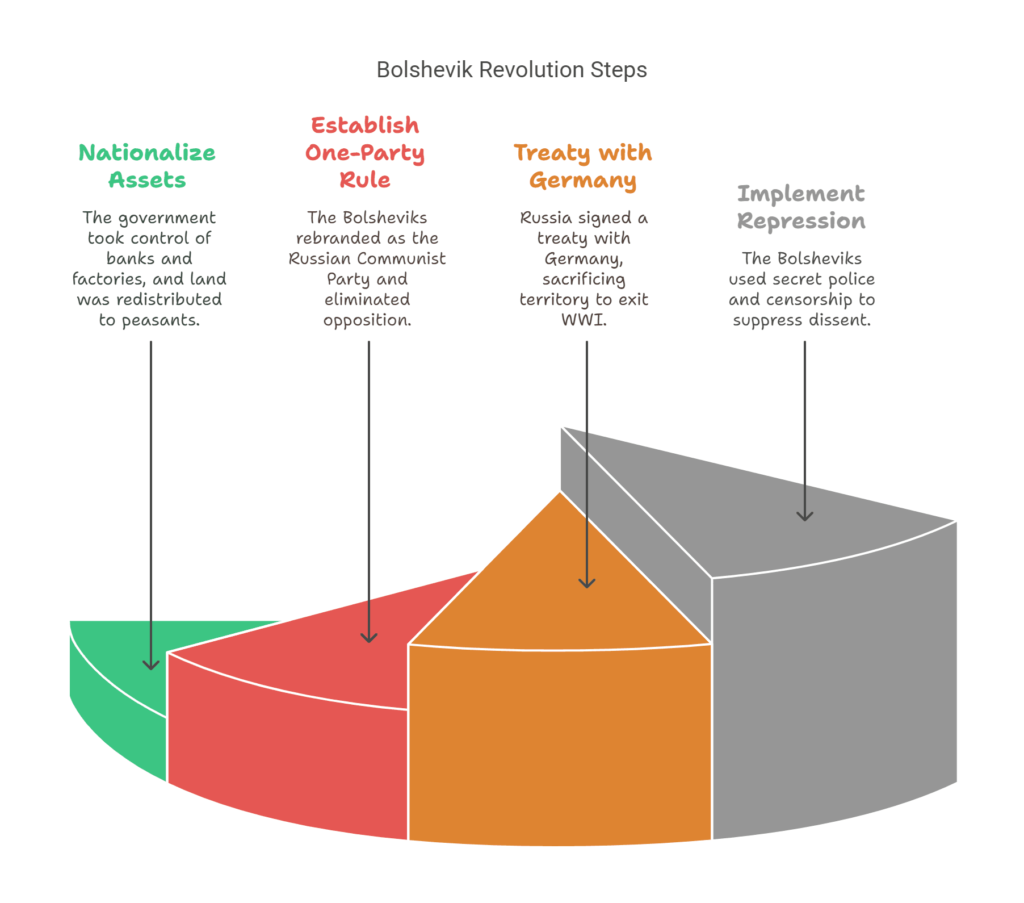
Did You Know? Writers like Mayakovsky wrote revolutionary poetry, but later many felt trapped by rules.
📊 New Russia vs. Old Russia
| Aspect | Old Russia | New Russia |
|---|---|---|
| Economy | Private factories, nobles’ land | Govt.-run industry, peasant land |
| Politics | Tsar’s autocracy | One-party Communist rule |
| Culture | Aristocratic titles, old art | Soviet hats, experimental art 🌟 |
❓ Quick Quiz: Test Your Knowledge!
MCQs:
- What happened to nobles’ land after October?
a) Sold to foreigners
b) Taken by peasants ✅
c) Turned into parks - Why did Lenin dismiss the Constituent Assembly?
a) It rejected Bolshevik plans ✅
b) It was too big
c) He preferred tea parties
Assertion & Reason:
A: The Cheka arrested critics of the Bolsheviks.
R: The Party tolerated no opposition.
(✔️ Both true! R explains A.)
Short Questions:
- Name one thing nationalized in 1917.
- What was the budeonovka?
(Answers: 1-Banks/Industries, 2-Soviet army hat)
💥 The Civil War Looms…
But not everyone loved the new Russia:
- Opponents: Tsar loyalists, liberals, foreign powers (UK, France, USA).
- Result: A brutal civil war (1918-1922)—Reds (Bolsheviks) vs. Whites (opponents).
Real-Life Connection: Imagine your classmates splitting into rival gangs over a new school rule—chaos ensues! 😱
Next Up: The Civil War—where blood, betrayal, and survival decide Russia’s fate! ⚔️❄️
Teaser: How did the Bolsheviks win against all odds? Spoiler: War communism, propaganda, and a secret police force! 🔍🔥
🌪️ The Civil War: Reds vs. Whites vs. the World!
1. Why Did the Civil War Start?
After the Bolsheviks took power, Russia exploded into chaos:
- Soldiers Deserted: Peasant-soldiers fled to grab land during redistribution 🏃♂️🌾.
- Opponents United: Liberals, Tsar-lovers (Whites), and Socialist Revolutionaries (Greens) teamed up to crush the Bolsheviks (Reds).
- Foreign Meddling: France, USA, UK, and Japan sent troops—scared of socialism spreading! 🌍💣
Real-Life Connection: Imagine your siblings ganging up on you and their friends join in—that’s Lenin in 1918! 👨👧👦
2. Who Fought Whom?
| Group | Who Were They? | Backed By |
|---|---|---|
| Reds | Bolsheviks (Communists) | Workers, some peasants |
| Whites | Ex-Tsarists, liberals, landlords | Foreign powers (USA, UK etc.) |
| Greens | Socialist Revolutionaries (peasants) | Villages, anti-Bolsheviks |
Fun Fact: The Whites hated each other more than the Reds—like rivals forced to group-project! 📚💥
3. How Did the Reds Win?
- Peasant Support: Reds promised land, while Whites punished peasants who took it.
- Propaganda Power: Posters screamed, “Defend the Revolution!” 🖼️🔥
- Foreign Troops Left: After WWI ended, other countries lost interest.
Quote Alert:
“The Whites had armies, but the Reds had a cause.” — A Red Army soldier.
4. Bloodshed & Confusion
- Khiva Massacre (1920): Bolshevik colonists killed Central Asian nationalists, claiming to “defend socialism.” 😢
- Mixed Messages: Many asked, “Do the Bolsheviks stand for freedom… or just new rulers?”
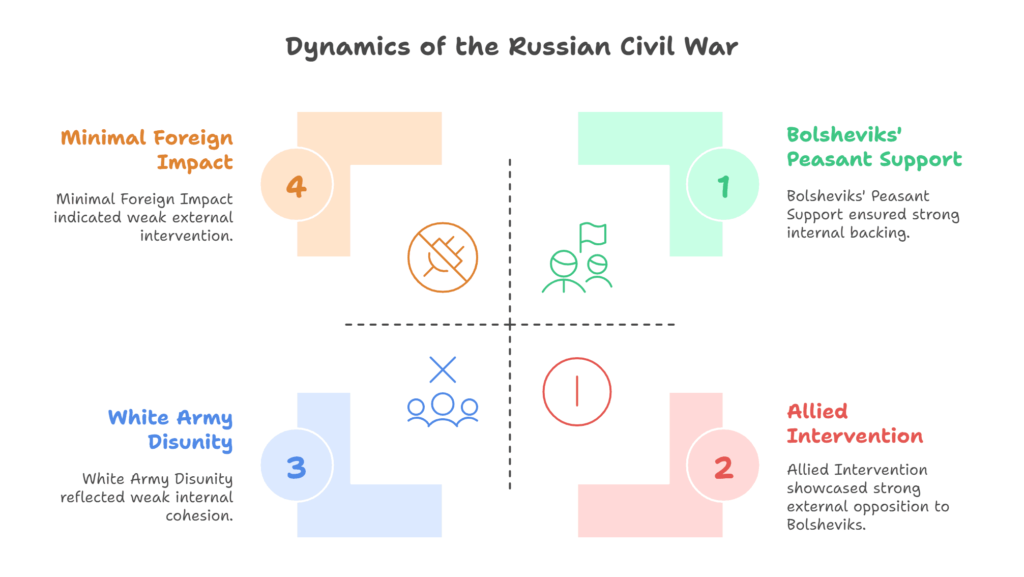
Real-Life Connection: Like a superhero team that starts fighting each other—who’s the real villain? 🦸♂️🦹♀️
5. Aftermath: Birth of the USSR
In December 1922, the Bolsheviks created the Soviet Union (USSR):
- Promised Autonomy: Non-Russian groups (e.g., Ukrainians, Georgians) got some self-rule.
- But… Harsh policies like banning nomadism made people resentful.
Did You Know? The USSR’s motto was “Workers of the world, unite!”—but unity was messy. 🌐⚒️
❓ Quick Quiz: Civil War Chaos!
MCQs:
- Who were the Whites?
a) Bolshevik supporters
b) Tsarists & liberals ✅
c) Foreign soldiers - Why did foreign troops leave Russia?
a) WWI ended ✅
b) They loved Lenin
c) Ran out of snacks
Assertion & Reason:
A: The Reds won the Civil War.
R: Peasants supported them over the Whites.
(✔️ Both true! R explains A.)
Short Questions:
- Name one country that sent troops against the Reds.
- What was the Khiva massacre?
(Answers: 1-France/USA/UK/Japan, 2-Bolsheviks killing Central Asian nationalists)
🌟 Recap Cheat Sheet
- Civil War: Reds vs. Whites/Greens/foreigners.
- Red Victory: Land promises, propaganda, enemy disunity.
- USSR Born: 1922, with shaky autonomy deals.
🏗️ Next Up: Building a Socialist Society!
After surviving civil war, the Bolsheviks faced their biggest test:
- Can you erase capitalism completely?
- How do you feed a starving nation?
- Spoiler: War Communism = grain seizures, riots, and… the NEP! 🌾💔
Teaser: Imagine your school bans grades but then brings them back—chaos? That’s Russia’s 1920s economic rollercoaster! 🎢
Coming Soon: Making a Socialist Society—where utopian dreams clash with hungry realities! 🥖✨
🏗️ Building a Socialist Society: Big Dreams, Tough Realities
1. Central Planning: The Five-Year Plans
Imagine your principal sets a 5-year plan to turn your school into a tech hub. That’s what the Bolsheviks did for Russia’s economy!
- How It Worked:
- Nationalized Everything: Factories, banks, and land controlled by the government.
- Five-Year Targets: Officials decided what to produce (coal, steel, machines) and how much.
- Results:
- Industrial Boom: By 1933, coal, oil, and steel production doubled! 🚂🏭
- New Cities: Built from scratch (like Magnitogorsk, a steel city).
But… Workers paid the price:
- Brutal Conditions: -40°C winters, 4-story dormitories with no toilets! ❄️🚽
- Strikes: 550 work stoppages in Magnitogorsk’s first year.
2. Social Reforms: Schools, Health & Homes
The Bolsheviks tried to improve lives:
- Education: Workers/peasants could now attend universities! 📚
- Healthcare: Free clinics opened (but often understaffed). 🏥
- Housing: “Model apartments” built… but most were cramped.
Real-Life Connection: Like getting a free gym membership but no equipment—good idea, poor execution! 💪
3. The Dark Side of Progress
- Unequal Benefits: Cities got more resources; villages were ignored.
- Propaganda Over Truth: Posters showed happy workers, but reality was grimmer.
Quote Alert:
“You can’t make an omelette without breaking eggs.” — Stalin
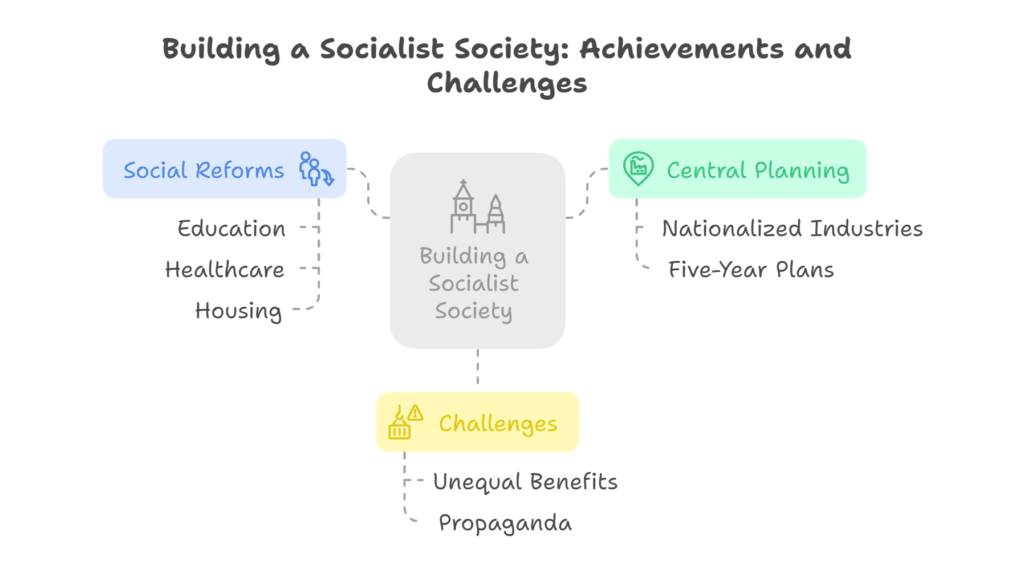
❓ Quick Quiz: Socialist Society Check!
MCQs:
- What doubled between 1929-1933?
a) Food production
b) Coal/steel output ✅
c) School holidays - Why did workers strike in Magnitogorsk?
a) Too many holidays
b) Harsh living conditions ✅
c) Free healthcare
Assertion & Reason:
A: The Five-Year Plans boosted industry.
R: The government set strict production targets.
(✔️ Both true! R explains A.)
Short Questions:
- Name one social reform by the Bolsheviks.
- What was built in Magnitogorsk?
(Answers: 1-Education/Healthcare/Housing, 2-Steel plant)
🌾 What’s Next? Stalin’s Collectivisation
The Bolsheviks faced a problem: “How do we feed cities and control farms?”
- Stalin’s Answer: Force peasants into collective farms (kolkhozes).
- Spoiler: Famine, resistance, and chaos followed.
Teaser: Imagine your principal forces all students to share lunchboxes—some get more, some starve. That’s collectivisation! 🍱💔
Up Next: Stalinism & Collectivisation—where farms become battlegrounds, and millions pay the price. 🌾🚜
🌾 Stalinism & Collectivization: Farms, Famine, and Fear
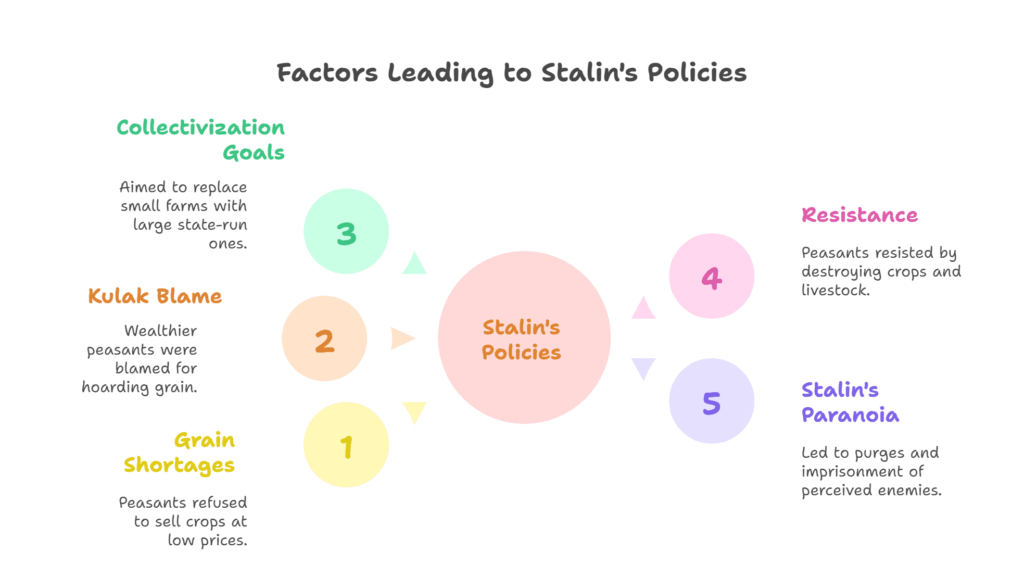
1. Why Did Stalin Force Farms to Merge?
In the late 1920s, Soviet cities were starving. Grain shortages hit hard because peasants refused to sell crops at low government prices. Stalin blamed kulaks (wealthier peasants) for hoarding grain. His solution? Collectivization:
- Goal: Replace small farms with giant state-run kolkhoz (collective farms).
- Promised Benefits: Modern machinery, higher production.
- Reality: Peasants hated it! They burned crops, killed livestock, and hid grain.
Fun Fact: By 1931, 1/3 of all cattle in the USSR were gone—peasants preferred slaughtering animals over handing them to the state! 🐄🔥
2. “You Will Collective Farm—Or Else!”
Stalin’s goons (Party members) stormed villages:
- Raided Homes: Seized grain and land.
- Deported Millions: Resisters were labeled “kulaks,” exiled to Siberia, or shot. ❄️🔫
- Famine Horror: Bad harvests + chaos → 1930-1933 famine killed 4 million.
Real-Life Connection: Imagine your school cafeteria takes your lunchbox daily—you’d hide snacks too! 🍎😡
3. Stalin’s Paranoia: The Great Purge
Even Party members questioned collectivization. Stalin’s response?
- Accusations: Critics = “Traitors to socialism!”
- Forced Confessions: Torture, fake trials, executions.
- Gulag Camps: By 1939, 2 million were in prisons or labor camps.
Quote Alert:
“Death solves all problems. No man, no problem.” — Stalin (allegedly).
❓ Quick Quiz: Test Your Knowledge!
MCQs:
- What was a kolkhoz?
a) A type of Soviet hat
b) A collective farm ✅
c) A secret police unit - How many died in the 1930-1933 famine?
a) 1 million
b) 4 million ✅
c) 10 million
Assertion & Reason:
A: Peasants destroyed their livestock during collectivization.
R: They resisted handing animals to the state.
(✔️ Both true! R explains A.)
Short Questions:
- Name one consequence of collectivization.
- Who were the kulaks?
(Answers: 1-Famine/livestock loss, 2-Wealthier peasants blamed by Stalin)
🌍 Global Ripples: The USSR’s Legacy
Stalin’s brutal policies shocked the world, but the USSR also inspired socialist movements globally. Next, we’ll explore how the Russian Revolution became a beacon—and a warning—for nations dreaming of equality.
Teaser: Ever wondered how a revolution in Russia influenced Vietnam, Cuba, or even your local labor union? Stay tuned! 🌎✨
Next Up: The Global Influence of the Russian Revolution—where ideas of socialism sparked fires (and fears) worldwide! 🔥📜
🌍 The Russian Revolution Goes Global!
1. A Spark That Lit the World
The Bolsheviks’ takeover in 1917 shocked the world. Socialist parties in Europe were skeptical (“They’re too extreme!”), but workers everywhere thought: “Wait—can WE create a workers’ state too?”
- Communist Parties Popped Up: From Britain to China, inspired by the USSR.
- Example: Ho Chi Minh (Vietnam’s future leader) trained in Moscow!
Real-Life Connection: Like a viral TikTok trend—everyone wanted to copy the “Soviet experiment”! 📱🔥
2. Comintern: The “Socialist Avengers”
The USSR created the Communist International (Comintern) in 1919—a global club for socialist parties.
- Goal: Spread revolution, train leaders, and fight colonialism.
- Cool Fact: India’s MN Roy attended the Comintern’s 1920 conference!
Quote Alert:
“Workers and oppressed peoples of the world, unite!” — Comintern slogan.
3. USSR’s Double Face: Hero vs. Villain
By the 1950s, the USSR was a superpower but had big problems:
- Achievements: Ended hunger, built industries, beat Nazis in WWII.
- Dark Side: No free speech, forced labor camps (Gulags), strict censorship.
Real-Life Connection: Imagine a school that wins sports trophies but bans students from speaking—mixed feelings! 🏆🤐
4. Socialist Ideals vs. Soviet Reality
Even socialists admitted: “The USSR isn’t the paradise we dreamed of.”
- Criticism: The USSR used fear, not freedom, to develop.
- Legacy: By the 1990s, the USSR collapsed, but socialist ideas lived on—reimagined in Cuba, Vietnam, and even worker rights movements.
Did You Know? Bernie Sanders’ 2020 campaign used ideas inspired by socialism—but very different from Stalin’s USSR! 🇺🇸✊
❓ Quick Quiz: Global Revolution Check!
MCQs:
- What was the Comintern?
a) A Soviet space program
b) A global socialist group ✅
c) A type of Soviet hat - Who trained in the USSR for Vietnam’s revolution?
a) Mahatma Gandhi
b) Ho Chi Minh ✅
c) Winston Churchill
Assertion & Reason:
A: The USSR’s reputation declined by the 1990s.
R: It used repression, not freedom, to develop.
(✔️ Both true! R explains A.)
Short Questions:
- Name one country inspired by the USSR.
- What was a key dark side of Soviet rule?
(Answers: 1-China/Vietnam/Cuba, 2-Censorship/Gulags)
🌟 Recap Cheat Sheet
- Global Impact: USSR inspired communist parties worldwide.
- Comintern: Socialist “fan club” to spread revolution.
- USSR’s Legacy: Mixed—heroic achievements but brutal rule.
- Socialism Today: Ideas reshaped into democracy, worker rights, and fair wages.
Conclusion: Socialism In Europe And The Russian Revolution
Why This Chapter:”Socialism In Europe And The Russian Revolution” Isn’t Just About the Past – It’s About You
Imagine standing in a frozen Petrograd in 1917, your breath visible in the air as crowds chant for “Peace, Land, Bread!” Now fast-forward to today. When you scroll through headlines about protests for fair wages, climate justice, or equality—you’re seeing the echoes of the Russian Revolution.
So what? Why care about a revolution from 100+ years ago?
Because this chapter isn’t just about dusty history books. It’s about ordinary people—like you—demanding change. The Bolsheviks weren’t superheroes; they were workers, students, and dreamers who dared to ask: “What if we built a world where no one starves while others feast?” Their victories and failures teach us:
- Change is messy: The revolution brought hope but also repression.
- Ideas outlive empires: Socialism reshaped the globe—from India’s labor laws to Cuba’s healthcare.
- Your voice matters: Just like the women who sparked International Women’s Day in 1917, you can challenge unfair systems.
Think about it:
- What would you have done as a factory worker in 1905?
- Could you spot a “Stalin” today—someone promising utopia but delivering dictatorship?
A Quote to Remember:
“Those who do not move, do not notice their chains.” — Rosa Luxemburg, a revolutionary who fought for a fairer world.
You May also want to read – The French revolution
FAQs – Socialism In Europe And The Russian Revolution
1. What is socialism and why did it emerge in Europe?
Socialism is an ideology advocating collective ownership of resources to reduce inequality. It emerged in Europe due to harsh industrial conditions, worker exploitation, and inspiration from thinkers like Karl Marx.
2. What were the main causes of the Russian Revolution of 1917?
Key causes included extreme poverty, Tsar Nicholas II’s autocratic rule, WWI losses, food shortages, and rising demand for workers’ and peasants’ rights.
3. Who were the Bolsheviks and what did they believe?
The Bolsheviks, led by Lenin, were a radical socialist group advocating revolution to establish a proletariat (worker) state. They opposed capitalism and the Provisional Government.
4. What was the significance of the October Revolution?
The October Revolution (1917) marked the Bolsheviks’ takeover of power, leading to the end of the Provisional Government and the creation of the world’s first socialist state.
5. How did Lenin’s April Theses shape the Russian Revolution?
Lenin’s April Theses demanded ending WWI, transferring land to peasants, and nationalizing banks, which became the blueprint for Bolshevik policies.
6. What was Stalin’s collectivization policy and its impact?
Stalin’s collectivization forced peasants into state-controlled farms (kolkhoz), causing famine (e.g., Holodomor) but modernizing agriculture for Soviet industrialization.
7. How did the Russian Revolution influence global politics?
It inspired socialist movements worldwide, led to the USSR’s formation, and intensified Cold War tensions between capitalist and communist ideologies.
8. What were the differences between the February and October Revolutions?
The February Revolution (1917) overthrew the Tsar, establishing a Provisional Government. The October Revolution saw Bolsheviks seize power, ending capitalist rule.
9. Why did the Russian Civil War (1918–1922) occur?
The Civil War erupted between Bolsheviks (Reds) and anti-communist forces (Whites), backed by foreign powers opposing socialism.
10. What were the social conditions in Russia before 1917?
Pre-revolution Russia faced stark inequality: aristocrats owned land, workers endured 12-hour shifts, and peasants faced famine, fueling revolutionary sentiment.








